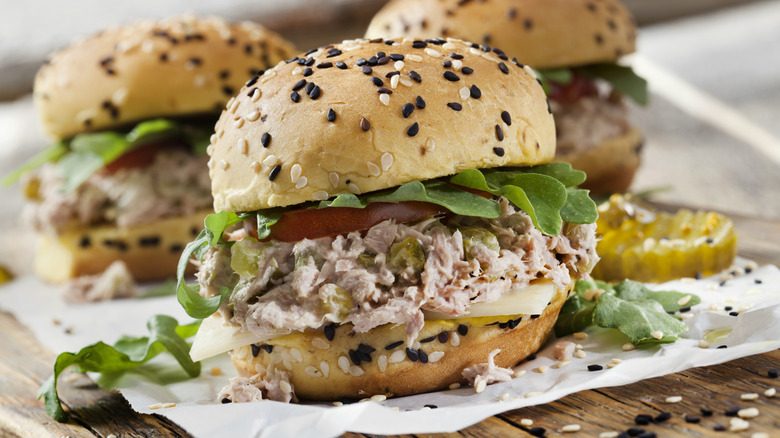Imitation Crab Is The Addition Your Tuna Salad Deserves
Cooking provides many at-home chefs with a creative outlet, especially when it comes to time-tested recipes. Tuna salad has been a classic go-to for a quick lunch for decades, though it may not always be the most appetizing. Fans of fish and mayo are sure to get their kicks with an original take on the sandwich, but with such a tried-and-true staple, it's natural for tuna salad to get a bit boring. The good thing about the recipe is that it is easy to enhance. In addition to the base ingredients, the sandwich is one of those foods that is asking for improvisation.
If you are a fan of sushi as well as convenient eating, try putting in some imitation crab next time you whip up a tuna salad batch. Because the texture of crab and tuna is comparable, the former is a natural ingredient to add. Shred imitation crab easily and it fits in seamlessly with the tuna. Even replacing tuna with imitation crab is a way to give an ordinary sandwich a certain flair. This different ingredient can stop food boredom in its tracks while maintaining a specific seafood taste.
Imitation crab is an all purpose ingredient
Imitation crab is just what it sounds like — a replacement for real crab. But while it may be off-putting to some to use a substitute, it is more common than you may realize. Imitation crab is actually the ingredient most commonly used when we think of crab. Prevalent in sushi and seafood salads, imitation crab is customarily used because of its low cost. Of course, there is nothing quite like chunks of delectable and authentic lump crab in your crab cakes, but that isn't always financially realistic. Real crab faces the plights of many other seafood. High demand and a limited supply cause a high market value. Instead, recipes commonly use imitation crab; most people wouldn't know the difference.
And after all, imitation crab — or crab stick — is still technically seafood. Referred to as surimi, the term translates to "ground meat." A recipe of minced fish parts and crab extract, the crab stick is processed into a paste and formed into a shape resembling crab legs. This method of production allows the purchase of crab to be more reasonable. It also has the added benefit of being cooked through when it reaches the store. With no need to prepare it any further, it is easy to throw it in salads or enjoy it straight from the bag.
Uses for imitation crab
Health experts such as Healthline will point out that imitation crab is not as healthy for consumers as crab meat. There isn't a lot of ground to dispute this. The fish that is largely used to create crab sticks is Pollack, which, unlike real crab, doesn't offer as much protein. Just like hot dogs, imitation crab is processed and, therefore, has a lot of other ingredients in the mix. This is where you can get creative with the crab alternative. Using it in tuna salad makes it easier to add more nutrients to the mix. Tuna is a high source of protein, and tuna salad offers opportunities to add more vegetables and ingredients to enhance it further.
There are many other dishes you can utilize with imitation crab, as well. Dips, fried rice, and even pizza recipes have interesting uses for the substitute. One TikToker showcased an inspired sushi bake with salmon and imitation crab. Using salmon in a sushi bake with rice offers additional nutrition. Her video also has a refreshing take on defending imitation crab. "You think I'm serving real crab on a Tuesday night?" she asked rhetorically. Imitation crab may not have the benefits of real crab, but we all have to make do in this economy.


